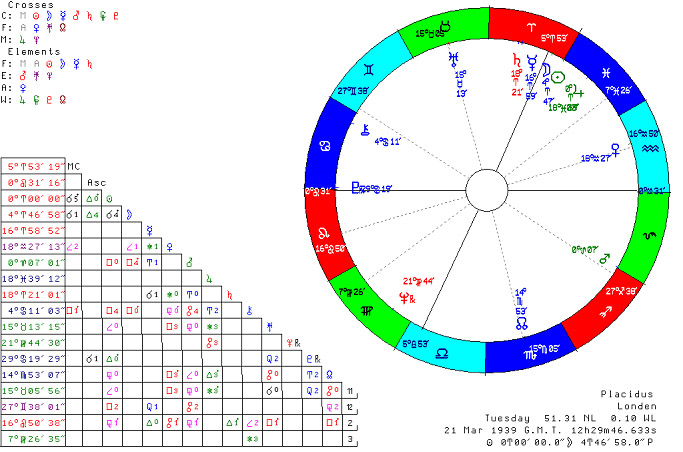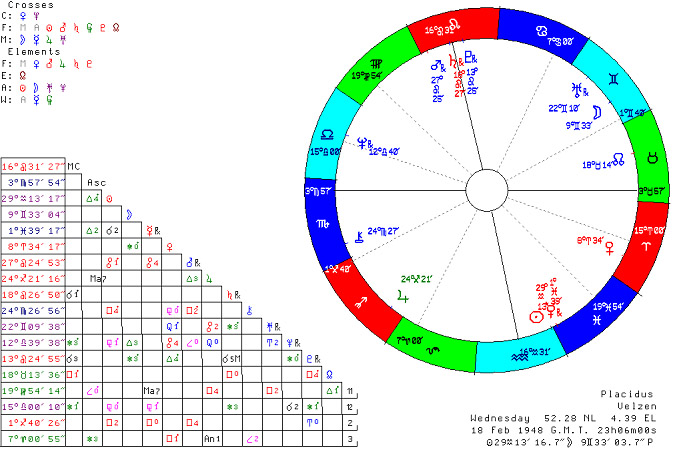Wim van Dam's Corner
|

|
Actual Point: are aspects to be seen as distances in signs or as distances in degrees ? If in signs, it is logical to deny the conjunction and the sextile mentioned above. If in degrees, there is nothing wrong what so ever with transgressional aspects. For the sign-fans however there is at least one trap: if you use broken aspects, that are not a number of whole signs (30 degrees), you get into trouble. For example, what is the nature of the semi-square, 45 degrees? It is often stated that one can recognize the nature of an aspect by measuring it from 0 Aries. For example the trine, 120 degrees, is measured from 0 Aries to 0 Leo, is from fire to fire, is “good”. The square, 90 degrees, is from 0 Aries to 0 Cancer, is from fire to water is bad etc. This way, the semi-square is from 0 Aries to 15 Taurus, is from fire to earth, is bad. This seems quite logical, but what if the semi-square is from the middle of Aries to the beginning of Gemini, f.e. from 14.50 Aries to 0.10 Gemini? The perplexing answer I once got on this question 1) was: in such a case the semi-square is a far more benevolent aspect, since now it is from fire to air. Imagine this: a semi-square from 15.05 Aries to 29.55 Taurus (fire to earth) is principally bad, but if the second planet is positioned in 0.05 Gemini, just 10 minutes of arc further on, the very same aspect, only having become exact, also has changed its character from bad to good. Isn’t this unbelievable? It is amazing! What about the sesquiquadrate, 135 degrees? It is reckoned from 0 Aries to 15 Leo, is from fire to fire, so it should be good but is almost universally considered bad. The same for the quintile, 72 degrees, from 0 Aries to 12 Gemini, fire to air, is good, but its supplement, the tredecile (108 degrees, a powerful aspect) is from 0 Aries to 18 Cancer, from fire to water, should be bad while it is principally as benevolent as the quintile.
The Angelman on the other side is far too clever to meet upon such difficulties: he uses only the traditional Ptolemaic ‘whole’ aspects and thinks he therefore faces no theoretical problem at all. (Frawley, p. 81-90). But does he? It is unclear why, if one reckons with aspects based on signs, one should use orbs. If one planet is placed in 5 Aries, and the natural basis for the trine is the nature of the sign, in this case fire, then why should this planet not be in a trine to another planet in 29 Leo? The natural orb therefore would be the edge of the signs (in Hindu-astrology aspects indeed are measured thus). But even Frawley does not agree with this, so he too has to handle with what is in fact an inconsistent system. Simply stated: if it is the nature of the sign that counts, then what is the use of an orb? Far easier (and quite in agreement with both logic and everyday astrological practice) it is to apply the broken aspects of 45, 135, 72 and 108 degrees and to accept transgressional aspects. A classical example is the following case: In 1939, many British astrologers failed to see that year Britain was to come into war with Germany. For C.E.O. Carter, this was the reason to write a study on the subject of mundane astrology in order to evaluate its several techniques. When we consider now the horoscope of the 1939 solar ingress into 0 Aries for Britain’s capital, a standard technique in mundane astrology, the first thing that strikes the eye is Pluto’s (29 Cancer 19’29’’) quite narrow conjunction to the ascendant in 0 Leo 31, although it is a transgressional aspect:
Pluto’s nature had not yet completely been determined at the time, so we can’t blame our then colleagues. Analyzing this aspect now, this indication together with the square from the sun to Mars, would be sufficient to draw the conclusion of war. We may also take the horoscope of the murdered Dutch politician Pim Fortuyn as an example:
Here we see the sun in 29.13 Aquarius and Mercury in 1.39 Pisces, both are in their detriment. Are we to really believe that,
What we see in this horoscope is of course a most powerful opposition from Mars in ten to its ruler the sun and to Mercury, ruler of eight, standing together in their detriment, all three planets standing in a square to cusp eight and in a semisquare/sesquiquadrate to cusp 12 (the traditional secret enemies). Even the opposition of Neptune, natural ruler of twelfth, and its ruler Venus, actual ruler of twelve, also partakes in this configuration. Neptune is exactly semi-square to Mars and therefore by translation of light sesquiquadrate to cusp eight and to sun-Mercury. Venus in its turn is opposite to Neptune and although its orb is significantly wider, by translation of light this too partakes in the aspects to Mars, the sun, Mercury cusp eight and cusp twelve. A most impressive configuration in a most impressive horoscope. CONCLUSION Returning to our subject: for those who do not accept transgressional aspects, all depends on the “natural” link between signs of the same element (‘fire to fire is good’) and the “natural” enmity between signs of the same quality (‘cardinal to cardinal is bad’). This I have never understood. Why should signs within the same element (fire, earth, air, water) be friendly to each other and signs of the same quality (cardinal, fixed, mutable) be inimical? It will have become clear now that here we have a classical example of a circular argument: if we suppose an aspect of 90 degrees, or rather three signs, is bad and should, without transgression, always be calculated between signs of the same quality, then it seems logical that such signs are inimical to each other. Therefore, it is clear on its turn that a square should always be measured within signs of the same quality. In the same way, signs that have their starting points 120 degrees from each other, as fire to fire, would seem to be principally related. Thanks to the broken aspects, discovered by Kepler, we now know that fire to water (108 degrees, cardinal to cardinal) can be principally good, just as fire to fire (135 degrees, cardinal to fixed) can be principally bad. This makes possible a variety of interpretations that otherwise would be unthinkable. If you are a sign-ist, you would have to interpret any aspect from a fixed sign to a fixed sign in terms of a square, i.e. unfavourably, like ‘stubborn, headstrong’. A degree-ist however would use such an interpretation only in case of a real square, say from 15 Taurus to 15 Leo. If the aspect, between the same signs, is a tredecile from 5 Taurus to 23 Leo, he might use a positive description like ‘loyal, reliable’. Thus using transgressional aspects can be said to not only make your astrology more consistent but also to enrich it considerably. FINAL CONCLUSIONS:: Theoretically speaking, one might defend the vision that transgressional aspects do not have any value. But then, in order to have a consistent theory, one:
1) Karen Hamaker Zondag, personal communication Reference: |

